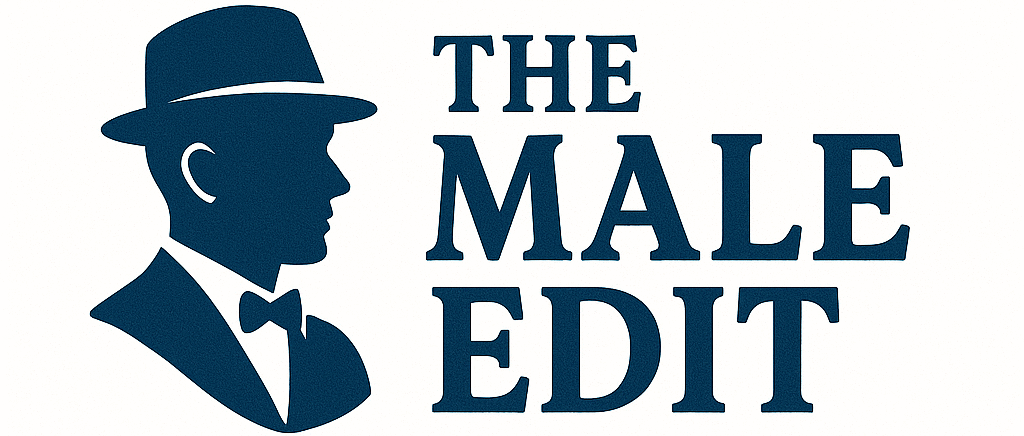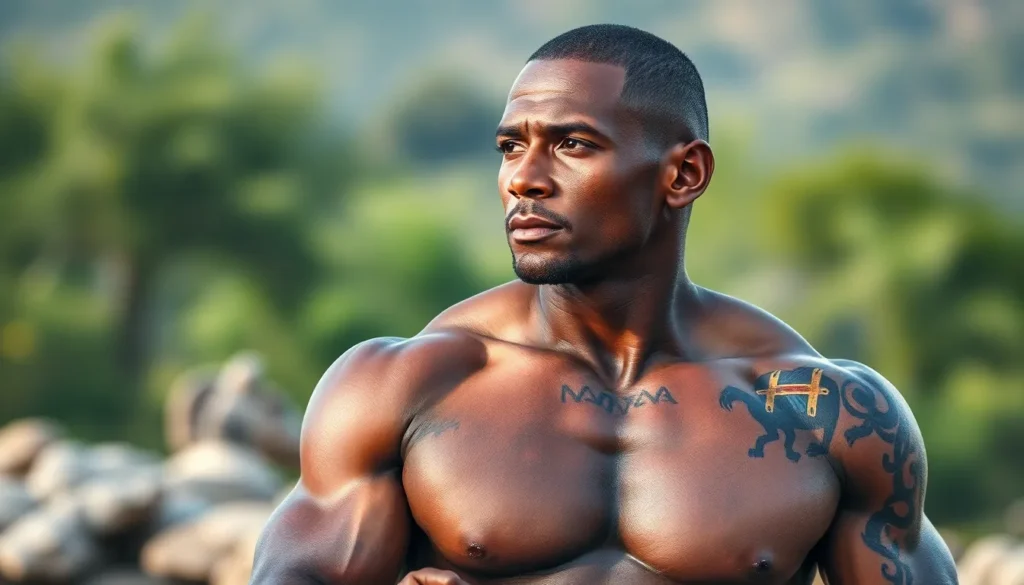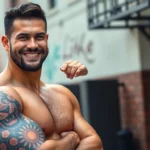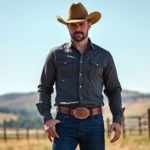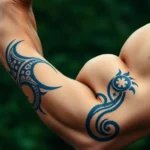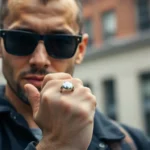African warrior tattoos represent one of the most powerful and meaningful tattoo choices for men seeking to honor strength, courage, and ancient traditions. These striking designs draw inspiration from the rich history of African tribes, legendary warriors, and cultural symbols that have represented bravery for thousands of years.
We’ve seen a massive surge in popularity for these tattoos as more men discover the profound symbolism behind Zulu warriors, Maasai fighters, and other iconic African tribal figures. The intricate details and bold imagery make these tattoos perfect for showcasing masculinity while paying respect to a culture that values honor and warrior spirit.
Whether you’re drawn to the fierce expressions of tribal masks, the detailed spears and shields of ancient warriors, or the geometric patterns that tell stories of conquest and survival, African warrior tattoos offer endless possibilities for creating a truly unique piece of body art that speaks to your inner strength.
Traditional African Warrior Symbols and Their Meanings in Tattoo Art
These ancient symbols carry deep spiritual and cultural significance that transforms modern tattoo art into powerful expressions of heritage. We’ll explore the most meaningful traditional elements that make African warrior tattoos truly authentic.
Tribal Masks and Their Spiritual Significance
Tribal masks represent the connection between the physical and spiritual worlds in African warrior culture. We see these designs featuring intricate geometric patterns that symbolize ancestral wisdom and divine protection during battle.
Dogon masks from Mali showcase elaborate vertical elements that represent the link between earth and sky. These tattoo designs often incorporate bold lines and angular shapes that create striking visual impact on the skin.
Yoruba warrior masks feature powerful expressions that embody the fierce spirit of ancient fighters. We find these designs particularly effective when rendered in black ink with subtle shading to highlight their dramatic features.
Fang masks from Equatorial Guinea display elongated faces that symbolize the warrior’s ability to see beyond the physical area. These tattoos work exceptionally well as chest pieces or back designs where their vertical orientation can be fully appreciated.
Spears and Shields as Symbols of Protection
Spears symbolize the warrior’s readiness to defend his tribe and family from any threat. We observe these designs featuring detailed spearheads with traditional African metalwork patterns that add authentic cultural elements.
Maasai spears showcase distinctive blade shapes that represent different warrior ranks and achievements. These tattoo elements often incorporate flowing lines that create ever-changing movement across the skin.
Zulu shields display iconic cowhide patterns with exact color combinations that indicated the warrior’s regiment and battle honors. We recommend these designs for larger tattoo pieces where the intricate hide patterns can be properly detailed.
Assegai spears feature shorter, more compact designs that work perfectly for forearm or leg tattoos. These weapons symbolize precision and skill in combat, making them ideal for men who value tactical thinking and strategy.
Animal Totems Representing Strength and Courage
Lions embody the ultimate symbol of courage and leadership in African warrior traditions. We see these designs featuring powerful manes and fierce expressions that capture the king of beasts’ commanding presence.
Elephants represent wisdom, memory, and unstoppable force in battle. These tattoos often showcase detailed trunk positions and ear patterns that hold exact meaning about the warrior’s role within his community.
Leopards symbolize stealth, agility, and the ability to strike with deadly precision. We find these designs particularly effective when combined with traditional African dot work patterns that mimic the animal’s spotted coat.
Buffalo represent determination and the warrior’s ability to charge forward even though overwhelming odds. These powerful animals make excellent tattoo subjects for men who value persistence and unwavering resolve in facing life’s challenges.
Popular African Warrior Tattoo Designs for Modern Men
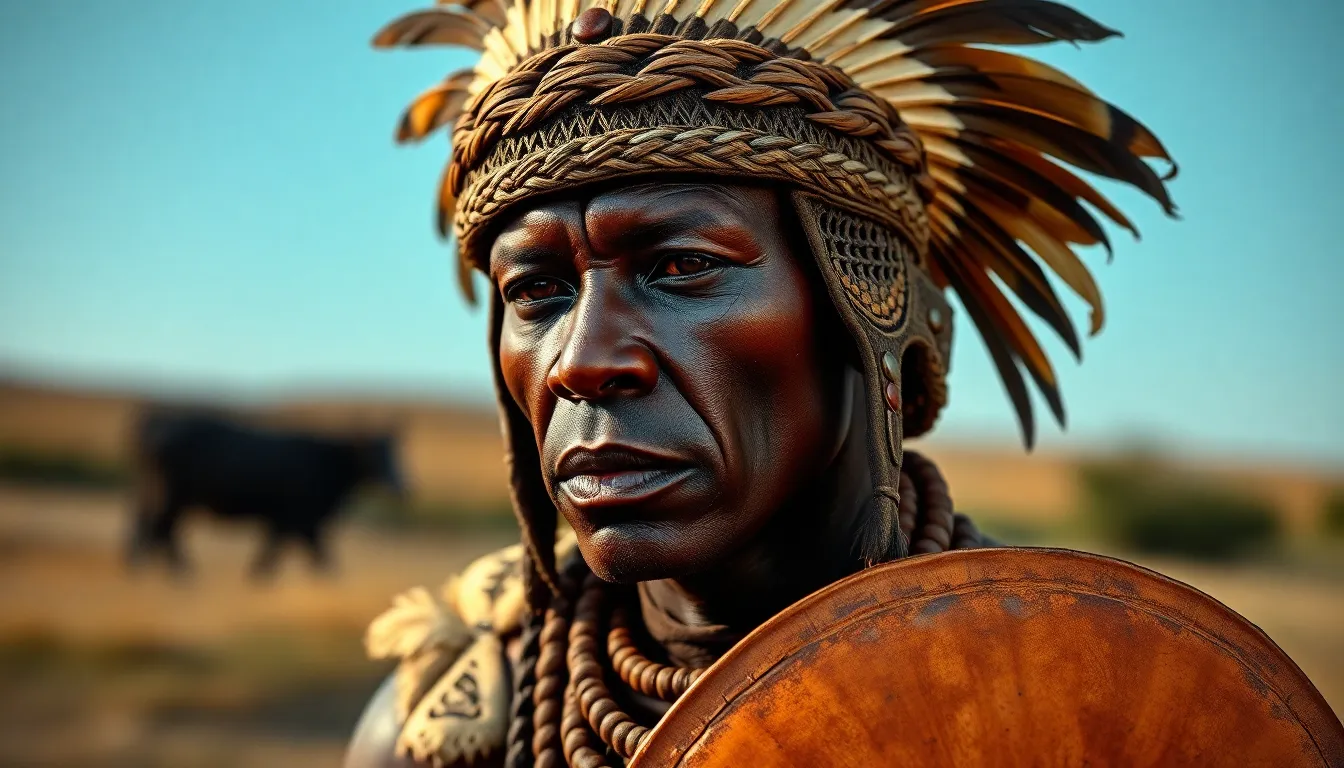
Building on the spiritual symbols we’ve explored, let’s examine the most sought-after warrior designs that capture the essence of Africa’s legendary fighters.
Zulu Warrior Portrait Tattoos
Zulu warrior portraits honor the legendary fighters known for their fierce bravery and exceptional leadership skills. These detailed tattoos showcase warriors wearing traditional rawhide helmets adorned with feathers and carrying distinctive cowhide shields that symbolize tribal pride. Portrait designs typically feature strong facial expressions and ceremonial war paint that emphasize the warrior’s connection to ancestral spirits.
Shaka Zulu emblems represent the pinnacle of warrior leadership and fighting spirit. These motifs incorporate the iconic assegai spear and the distinctive ishlangu shield patterns that defined Zulu military prowess. Artists often combine portrait elements with geometric borders that reflect traditional beadwork and tribal markings exact to Zulu culture.
Maasai Warrior Silhouettes and Tribal Patterns
Maasai warrior silhouettes capture the distinctive posture and weaponry of East Africa’s most renowned fighters. These designs feature elongated figures holding traditional spears and rungu clubs while wearing the characteristic red shuka cloth that identifies Maasai warriors. Silhouette tattoos emphasize the warrior’s lean build and proud stance that symbolizes agility and readiness for battle.
Geometric patterns surrounding Maasai figures incorporate traditional beadwork designs that represent cultural identity and protection. Red, blue, and white color schemes mirror authentic Maasai jewelry and clothing while circular and diamond patterns convey meanings related to cattle, family, and tribal unity. These intricate designs capture the resilience and pastoral lifestyle that defines Maasai warrior culture.
Ancient Egyptian Warrior Gods and Pharaohs
Egyptian warrior god tattoos feature deities like Horus and Anubis who embodied divine military power and protection. Horus designs showcase the falcon-headed god with traditional Egyptian armor and the distinctive eye symbol that represents royal protection. Anubis tattoos incorporate the jackal-headed figure with ceremonial weapons and hieroglyphic elements that convey authority over the afterlife battlefield.
Pharaoh warrior portraits highlight rulers known for their military conquests and divine status. These designs feature ornate headdresses, ceremonial beards, and traditional Egyptian weaponry like khopesh swords and composite bows. Artists often incorporate hieroglyphic backgrounds and sacred symbols that emphasize the pharaoh’s role as both earthly commander and divine protector of Egypt.
Best Body Placement Options for African Warrior Tattoos
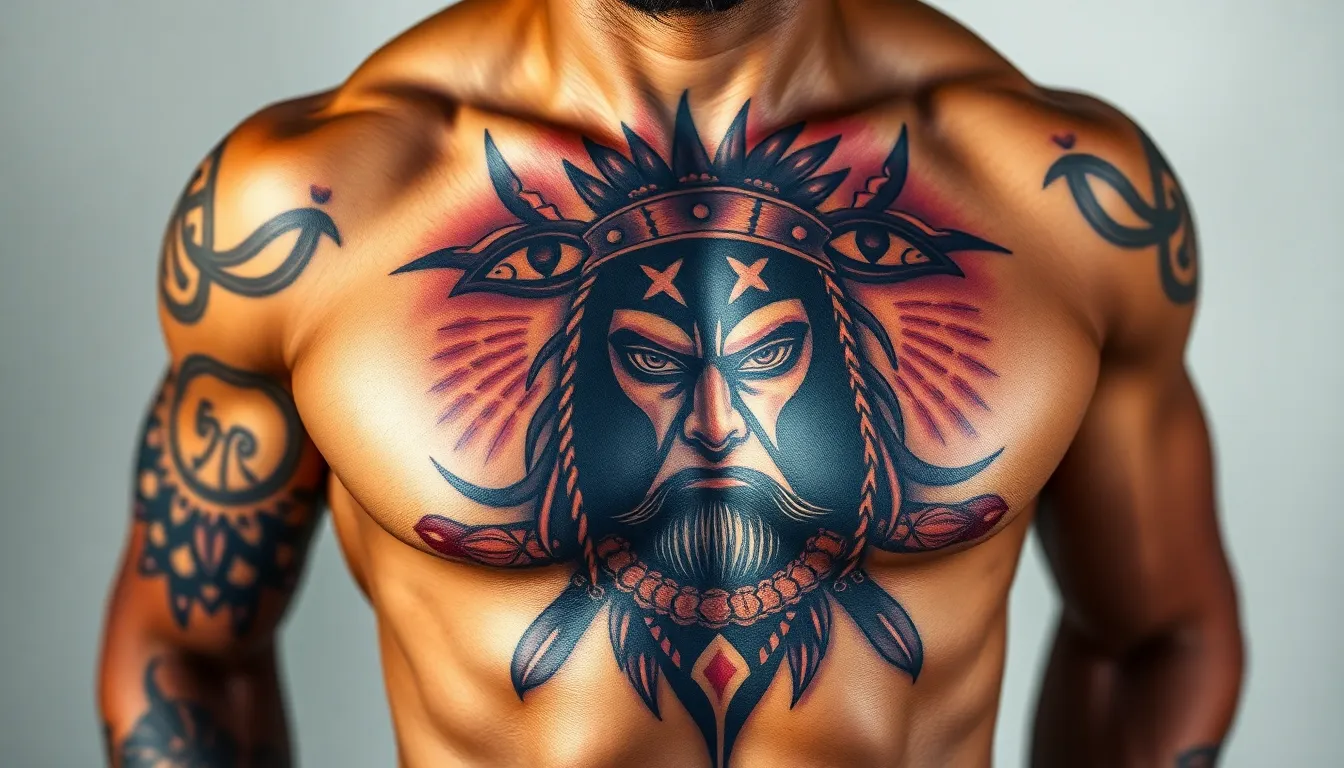
Choosing the right placement for your African warrior tattoo ensures maximum visual impact and proper representation of these powerful cultural symbols.
Chest and Torso Designs for Maximum Impact
Chest placements showcase African warrior tattoos with commanding presence and symbolic meaning. The broad canvas of your chest allows for detailed depictions of warrior figures, complete with traditional armor and tribal markings that represent strength and protection. We recommend this area for large-scale warrior kings or ancestral guardians, where intricate patterns and culturally important symbols can be fully displayed.
Torso designs accommodate expansive warrior narratives that tell complete stories. Your ribcage and side areas provide vertical space perfect for depicting proud African warriors in their full regalia, including shields, spears, and ceremonial dress. These placements allow artists to incorporate multiple elements like lions, elephants, and geometric patterns that enhance the overall spiritual significance of your tattoo.
Upper chest positioning creates a powerful focal point for warrior portraits. This placement works exceptionally well for detailed faces of legendary fighters from tribes like the Zulu or Maasai, where every line and shadow can represent the courage and resilience of African heritage. The natural muscle definition in this area adds dimension to warrior imagery, making the tattoo appear more lifelike and impactful.
Arm and Shoulder Placements for Visibility
Shoulder placements offer excellent visibility while maintaining professional discretion when needed. Your shoulder cap provides a rounded surface that complements the circular shields and tribal masks commonly featured in African warrior designs. This area works particularly well for medium-sized warrior emblems that can be easily showcased or covered depending on the situation.
Upper arm positioning allows for ever-changing warrior action scenes and weaponry displays. The natural flow of your bicep and tricep muscles enhances the movement in warrior tattoos, making spears appear more powerful and warrior stances more dramatic. We often see stunning results when tribal patterns and geometric designs wrap around the arm, creating a cohesive sleeve effect.
Forearm placements keep your African warrior symbols constantly visible and accessible. This area suits bold blackwork designs featuring warrior masks, ancestral symbols, or protective animals that represent your connection to African traditions. The forearm’s flat surface allows for clean, striking lines that emphasize the strength and pride associated with warrior culture.
Back Pieces for Large-Scale Warrior Scenes
Full back tattoos provide the ultimate canvas for elaborate African warrior narratives and battle scenes. Your back’s expansive surface accommodates multiple warriors, ancestral spirits, and protective animals in one cohesive design that tells a complete story of heritage and valor. This placement allows artists to incorporate detailed backgrounds featuring African landscapes, tribal villages, or spiritual symbols that enhance the overall meaning.
Upper back positioning works perfectly for warrior portraits combined with cultural elements. The shoulder blade area provides natural framing for warrior faces or figures, while the surrounding space can include traditional patterns, animal totems, or ceremonial objects that represent exact tribal affiliations. These designs create powerful statements about cultural identity and spiritual protection.
Lower back placements suit horizontal warrior scenes that span across your entire back width. This area accommodates processions of warriors, battle formations, or ceremonial gatherings that showcase the community aspect of African warrior culture. The natural curve of your lower back adds depth to these scenes, making them appear more three-dimensional and captivating.
Color Schemes That Enhance African Warrior Tattoo Designs
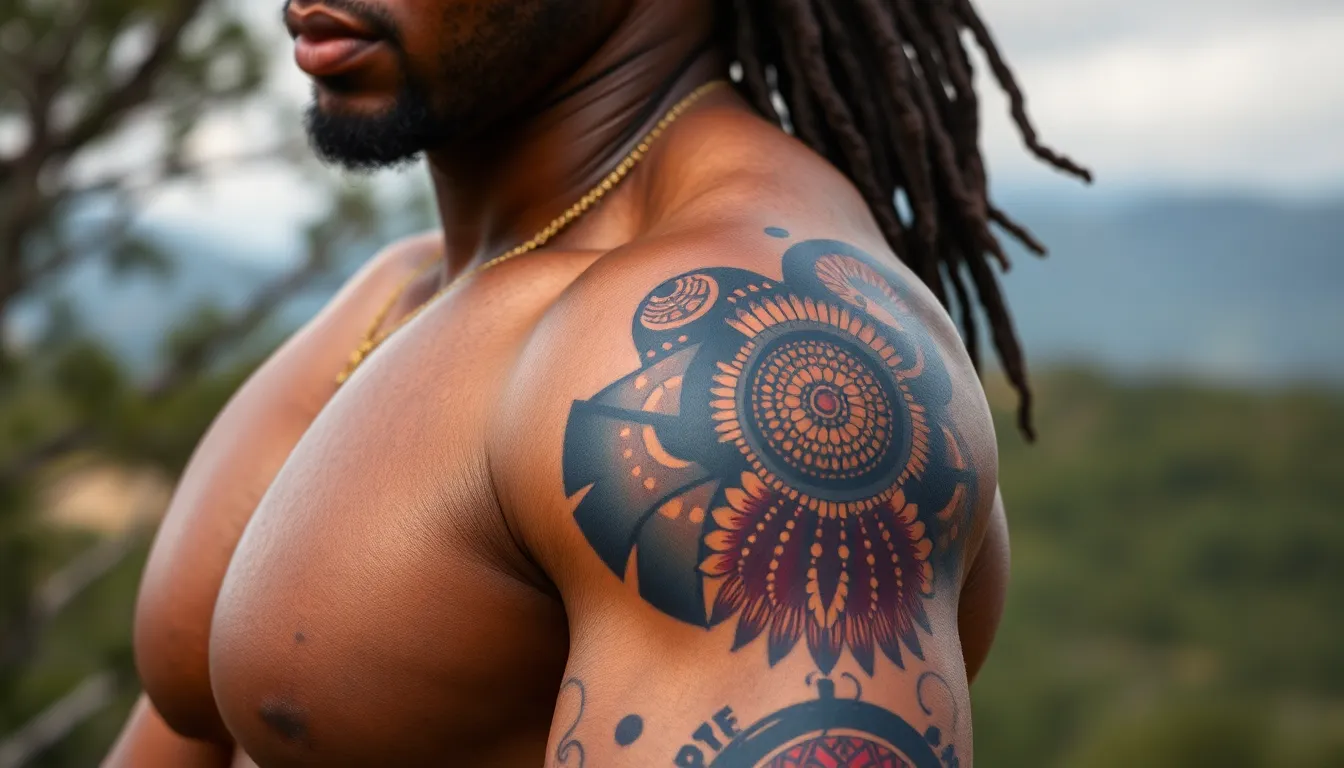
Choosing the right color palette transforms your African warrior tattoo into a masterpiece that honors both aesthetic appeal and cultural authenticity. We’ll explore three distinct color approaches that bring these powerful designs to life.
Traditional Black and Gray for Authentic Appeal
Black and gray tattoos deliver the most authentic representation of African warrior traditions. These monochromatic designs emphasize the warrior’s strength through bold tribal patterns and strong geometric lines that mirror traditional African art aesthetics. Artists achieve remarkable depth using varying shades of black ink to create shadows and highlights that make warrior figures appear three-dimensional.
Tribal styles flourish in black and gray palettes because they highlight the cultural origins of these designs without distraction. The stark contrast between deep blacks and subtle grays brings out intricate details in warrior armor, ceremonial masks, and traditional weapons. Blackwork techniques particularly excel at showcasing the bold geometric patterns that define authentic African tribal art.
Earth Tones and Natural Pigments
Natural earth tones connect African warrior tattoos to their ancestral lands through colors like browns, ochres, and muted greens. These pigments reflect the African industry and evoke the natural materials historically used in traditional body art and ritualistic markings. Artists blend these earthy hues to create warriors that appear grounded in their natural environment.
Ochre shades particularly resonate with African warrior symbolism because they mirror the clay pigments used in ceremonial body painting across various African cultures. Browns ranging from light tan to deep chocolate enhance skin tones in warrior portraits while maintaining cultural authenticity. Muted greens add subtle accents that represent the warrior’s connection to nature and the savanna.
Bold Reds and Golds for Royal Warrior Themes
Red and gold combinations elevate African warrior tattoos to royal status, symbolizing power, bravery, and leadership qualities. These vibrant colors emphasize the warrior’s regal heritage and connection to African warrior kings and esteemed tribal leaders. Artists use deep crimsons and rich golds to create ever-changing contrasts that command attention.
Royal warrior designs benefit from gold accents on armor, weapons, and ceremonial elements that reflect the warrior’s elevated status. Red pigments intensify the emotional impact of these tattoos while honoring the warrior tradition of using bold colors to signify courage and strength. Together, these colors create richly layered designs that capture both the warrior’s nobility and fierce determination.
Incorporating Cultural Elements Into Your African Warrior Tattoo
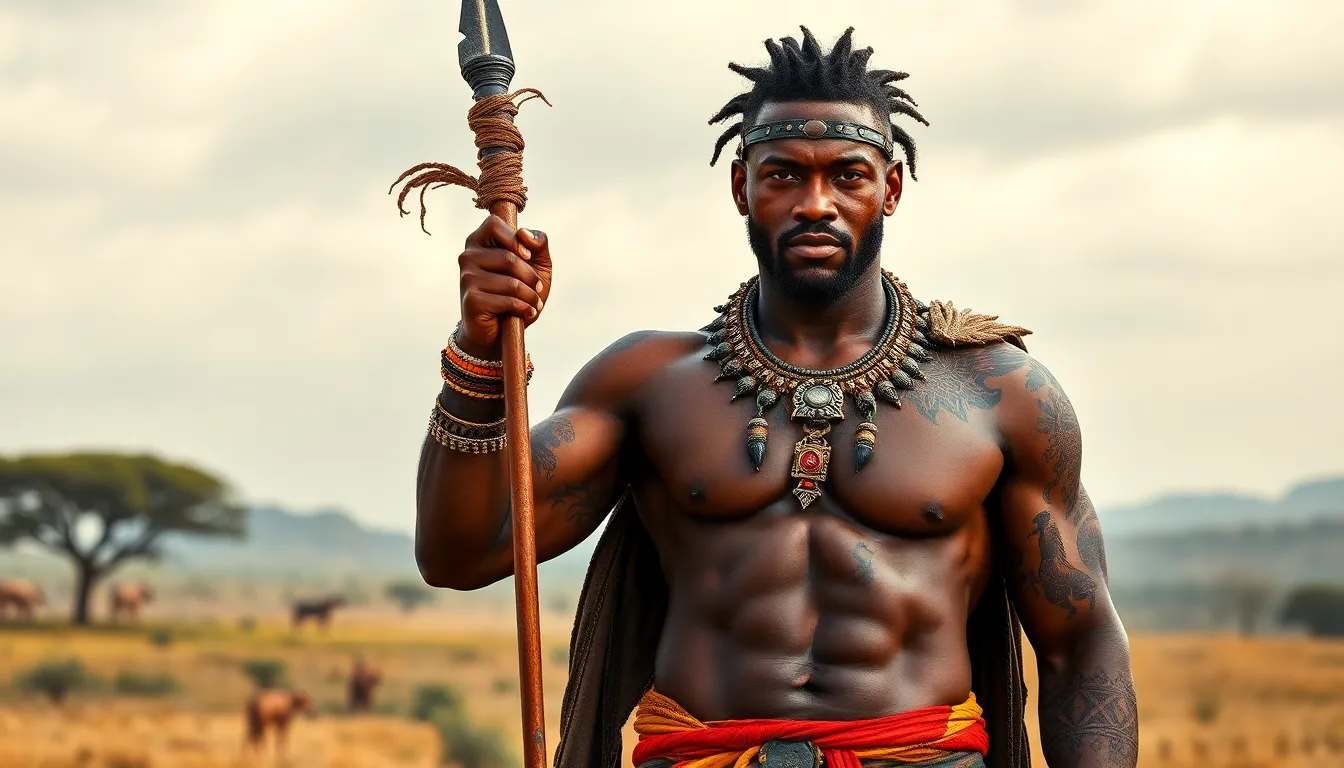
Authentic cultural elements transform an African warrior tattoo from a simple design into a meaningful tribute to ancestral heritage. We’ll explore essential components that ensure your tattoo respects and honors African traditions.
Authentic Tribal Patterns and Geometric Designs
Tribal patterns form the foundation of authentic African warrior tattoos, drawing inspiration from various indigenous tribes across the continent. Bold lines and symmetrical shapes create striking visual impact while representing traditional African artistry. Geometric designs symbolize protection, courage, and unity within tribal communities, making them perfect additions to warrior themed tattoos.
Blackwork and tribal styles emphasize these patterns through sharp contrasts and powerful shapes. We recommend incorporating circular motifs that represent life cycles, angular patterns that signify strength, and interlocking designs that show community bonds. These authentic elements ensure your tattoo connects directly to African artistic traditions rather than generic tribal imagery.
Sacred Symbols and Ancient Scripts
Sacred symbols add profound meaning to African warrior tattoos through their connection to exact cultural values and beliefs. Adinkra symbols from the Akan people of Ghana offer particularly rich options for meaningful tattoo elements. The Akoma symbol, featuring a hollow heart shape, represents tolerance and patience—essential virtues for any warrior.
Ancient scripts and symbolic markings create deeper narrative layers within your tattoo design. We suggest researching symbols that align with your personal values, such as Sankofa for learning from the past or Gye Nyame for the supremacy of God. These sacred elements ensure your tattoo carries authentic cultural narratives connected to honor, endurance, and spiritual strength.
Traditional Weapons and Armor Details
Traditional weapons serve as focal points that immediately identify your tattoo as an African warrior design. Spears and shields represent the primary tools of tribal warriors, each carrying exact cultural significance based on their tribal origins. Warriors wearing armor made of stones, beads, or animal teeth showcase the protective elements that defined African military traditions.
Detailed weapon depictions emphasize the warrior’s role as protector and community leader, connecting modern wearers to the legacy of legendary African fighters. We recommend including authentic armor accessories that reflect exact tribal customs, such as Maasai warrior jewelry or Zulu ceremonial elements. These traditional details highlight the tactical skills and resilience that made African tribal warriors renowned throughout history.
Choosing the Right Tattoo Artist for Your African Warrior Design
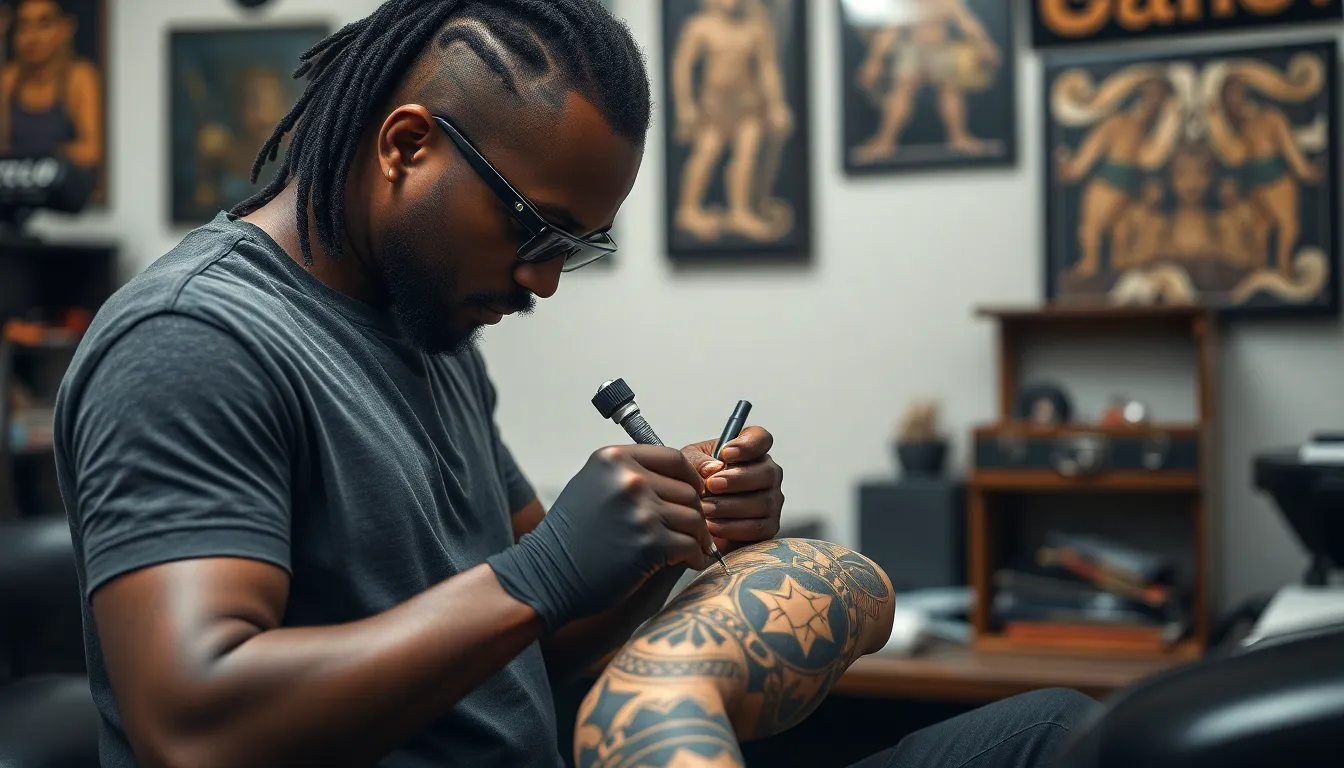
Selecting the perfect artist for your African warrior tattoo ensures cultural authenticity and artistic excellence. We’ll guide you through finding skilled professionals who understand the profound significance behind these powerful designs.
Finding Artists Specializing in Cultural Tattoos
Artists with experience in cultural and tribal tattoos possess deeper understanding of African art styles and their symbolic meanings. We recommend searching through online portfolios where you can examine their previous work with tribal designs and cultural motifs. Tattoo studios known for cultural work often house multiple artists who specialize in authentic representations of traditional imagery.
Community recommendations prove invaluable when seeking culturally sensitive artists. Local cultural organizations and online forums dedicated to African heritage can connect you with artists who value authenticity. Social media platforms showcase artists’ portfolios and allow you to see how they handle cultural elements in their designs.
Research artists who demonstrate familiarity with African warrior traditions through their completed works. Studios specializing in cultural tattoos typically maintain higher standards for historical accuracy and cultural respect. We suggest contacting multiple artists to compare their approach to cultural tattoo work before making your final decision.
Reviewing Portfolio Work and Cultural Sensitivity
Portfolio examination reveals an artist’s ability to create respectful and accurate cultural representations. We advise looking for previous African warrior tattoos that showcase traditional armor, tribal markings, and authentic warrior symbols like shields and spears. Artists who avoid stereotypical or appropriative designs demonstrate genuine respect for cultural heritage.
Quality portfolios display attention to detail in cultural elements such as traditional patterns and meaningful symbols. Review how artists incorporate spiritual symbolism and warrior imagery without distorting sacred meanings. Their work should reflect understanding of various African tribes’ distinct artistic styles and cultural significance.
Artists demonstrating cultural sensitivity carry out meaningful representations rather than generic tribal designs. We recommend examining their treatment of spiritual elements like warrior masks and ancestral symbols. Professional artists research cultural backgrounds before creating designs and show this knowledge through accurate depictions in their portfolio work.
Discussing Design Authenticity and Respect
Communication with your chosen artist ensures your tattoo honors African warrior traditions authentically. We encourage open discussions about the cultural background and exact meanings you want your design to express. Share your connection to the symbolism and explain why these elements resonate with your personal story.
Confirm that your design incorporates traditional elements respectfully without trivializing sacred symbols. Artists should understand the significance of warrior masks symbolizing spirituality and warrior king emblems denoting leadership and bravery. This collaboration creates tattoos rich in authentic symbolism that honor ancestral heritage.
Professional artists welcome conversations about cultural accuracy and help refine designs to maintain respectful representation. We suggest discussing exact tribal influences you’d like to incorporate and ensuring the final design celebrates rather than appropriates cultural elements. This approach guarantees your African warrior tattoo becomes a meaningful tribute to strength, courage, and cultural heritage.
Aftercare Tips for Large African Warrior Tattoo Pieces
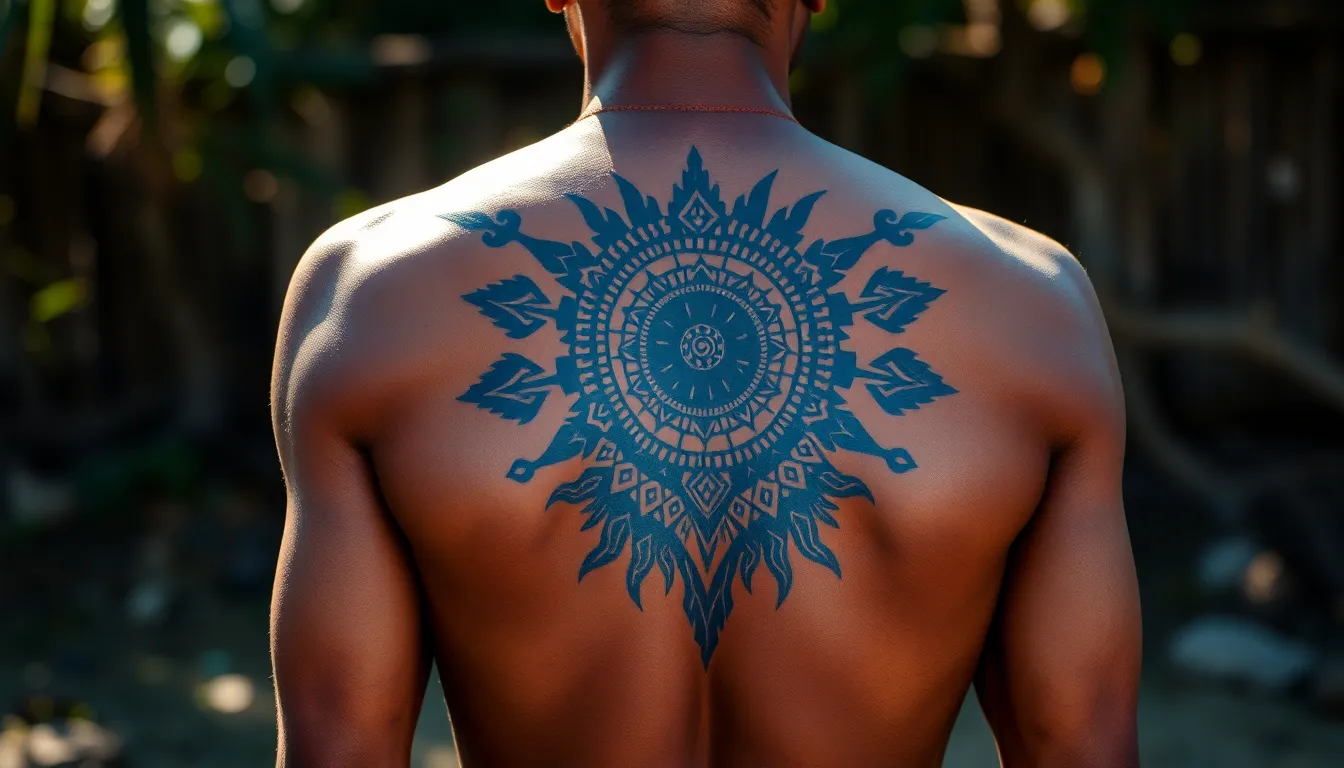
Large African warrior tattoos require specialized care to preserve their intricate details and cultural significance. We’ll guide you through essential aftercare practices that protect your investment and honor the artistic integrity of these powerful designs.
Proper Healing Techniques for Detailed Artwork
Clean your tattoo gently with mild, fragrance-free soap and lukewarm water during the initial healing phase. Pat the area dry with a clean towel and apply a thin layer of healing ointment or fragrance-free moisturizer to keep skin hydrated and promote proper healing.
Avoid picking or scratching the tattooed area, even when it begins to peel and flake naturally. Detailed African warrior designs contain intricate geometric patterns and fine linework that can be permanently damaged if you interfere with the natural healing process.
Keep your body hydrated by drinking plenty of water and maintaining a balanced diet to support skin regeneration. Your body needs adequate nutrients and hydration to heal the detailed artwork properly and maintain the sharpness of tribal patterns and warrior imagery.
Monitor for signs of infection including redness beyond the tattoo edges, excessive swelling, pus, or prolonged pain. These symptoms require immediate medical attention, especially with large pieces that cover important skin area.
Protecting Your Investment During Recovery
Limit physical activity that causes excessive sweating or movements that stretch the tattoo area during the 2-4 week healing period. African warrior tattoos often span large areas of the chest, back, or arms where muscle movement can disrupt healing.
Wear loose clothing to prevent abrasive fabrics from rubbing against your healing tattoo. Tight garments can cause irritation, scabbing, or damage to the detailed spear, shield, and tribal mask elements in your design.
Avoid direct sunlight and swimming to protect your tattoo from UV damage and potential infection. Swimming pools, hot tubs, and natural bodies of water contain bacteria that can compromise healing and fade the bold blackwork typical of African warrior designs.
Stay away from harsh chemicals including exfoliants, alcohol-based products, or heavily fragranced lotions that can irritate healing skin. Your African warrior tattoo contains detailed elements that need gentle care to maintain their crisp appearance.
Long-Term Maintenance for Vibrant Colors
Apply broad-spectrum sunscreen with SPF 30 or higher regularly to prevent fading from UV exposure. African warrior tattoos often feature bold reds and golds that represent power and bravery, making sun protection crucial for maintaining these vibrant royal themes.
Moisturize daily with gentle lotions designed specifically for tattoos to maintain skin elasticity and color brightness. Earth tones and natural pigments used in authentic African warrior designs require consistent hydration to prevent cracking and maintain their connection to ancestral lands.
Schedule periodic touch-ups with your original artist to refresh faded areas and maintain the integrity of geometric patterns and tribal markings. Professional maintenance ensures that symbols of protection like lions and elephants retain their cultural significance and visual impact.
Avoid excessive sun exposure and tanning beds that can accelerate fading and skin damage to your detailed artwork. Your African warrior tattoo represents not only artistic expression but also deep cultural and spiritual connections that deserve preservation through proper long-term care.
Conclusion
African warrior tattoos represent far more than body art – they’re powerful connections to ancestral strength and cultural legacy. When we choose these designs we’re embracing the courage and honor that defined legendary fighters throughout Africa’s rich history.
The journey from selecting authentic symbols to finding the right artist requires careful consideration and respect for cultural traditions. We’ve explored how proper placement color choices and meaningful elements transform these tattoos into lasting tributes to warrior heritage.
With proper aftercare and maintenance your African warrior tattoo will continue telling its story for years to come. These designs serve as daily reminders of the strength courage and resilience that flow through generations connecting us to the mighty warriors who came before us.
Frequently Asked Questions
What do African warrior tattoos symbolize?
African warrior tattoos represent strength, courage, honor, and ancient tribal traditions. They pay tribute to legendary fighters like the Zulu and Maasai warriors, embodying the fierce spirit and cultural heritage of African tribes. These tattoos connect wearers to ancestral values of bravery, protection, and warrior spirit.
Which African warrior designs are most popular for men?
Popular designs include Zulu warrior portraits with traditional helmets and shields, Maasai warrior silhouettes featuring distinctive postures and weaponry, ancient Egyptian warrior god tattoos (Horus, Anubis), and pharaoh warrior portraits. These designs capture the essence of Africa’s legendary fighters and their enduring legacy.
What body placement works best for African warrior tattoos?
Chest and torso are ideal for large-scale warrior narratives, while shoulders and arms offer great visibility for dynamic action scenes. Forearms keep symbols accessible, and full back pieces work perfectly for elaborate, multi-element designs that tell cohesive stories of heritage and valor.
What color schemes work best for these tattoos?
Three main approaches work well: traditional black and gray for authentic tribal appeal, earth tones and natural pigments that connect to ancestral lands, and bold reds and golds for royal themes symbolizing power and bravery. Each color choice enhances cultural significance and visual impact.
How do I choose the right tattoo artist for African warrior designs?
Look for artists specializing in cultural and tribal tattoos with portfolios showing deep understanding of African art styles. Seek recommendations from cultural organizations and online forums. Review portfolios for cultural sensitivity, accuracy, and respect for traditional elements while avoiding stereotypes.
What aftercare is needed for large African warrior tattoos?
Use gentle cleaning techniques, keep the tattoo hydrated, and monitor for infection signs. Protect during healing by limiting physical activity, wearing loose clothing, and avoiding sunlight and harsh chemicals. Long-term maintenance includes daily moisturizing, sunscreen application, and scheduling touch-ups when needed.
What cultural elements should be included for authenticity?
Incorporate tribal patterns and geometric designs from indigenous tribes, sacred symbols like Adinkra symbols from the Akan people, and traditional weapons and armor details. These elements add depth, personal significance, and connect modern wearers to the legacy of legendary African fighters.
What animals are commonly featured in African warrior tattoos?
Lions represent courage and leadership, elephants symbolize wisdom and strength, leopards embody stealth and determination, and buffalo represent resilience and power. These animal totems carry deep spiritual significance and reflect various warrior traits valued in African cultures.
